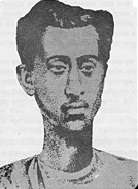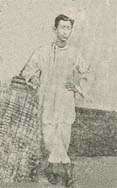Hiralal Sen
| Hiralal Sen | |
|---|---|
 Hiralal Sen | |
| Born | 1866 |
| Died | 1917 |
| Nationality | Indian |
| Occupation | Photographer, filmmaker |

Hiralal Sen (Bengali: হীরালাল সেন, Hiralal Shen) (2 August 1866 – 26 October 1917[1]) was an Indian photographer generally considered one of India's first filmmakers. He is also credited with creating India's first advertising films and quite possibly India's first political film. A fire in 1917 destroyed all of his films.
Early life
Hiralal Sen's native home was in Bagjuri, a village in Manikganj, approximately 80 km from Dhaka, the present-day capital of Bangladesh.[2] Although he was the son of a successful lawyer of a Baidya zamindar family of that region, he grew up in Calcutta.[2] In 1898, a film troupe en route to Paris screened a certain Professor Stevenson's short film along with the stage show, The Flower of Persia at the Star Theatre in Calcutta.[3] Borrowing Stevenson's camera, Sen made his first film, "A Dancing Scene" from the opera The Flower of Persia.[3] With assistance from his brother, Motilal Sen, he bought an Urban Bioscope from Charles Urban's Warwick Trading Company in London.[3] In the following year, with his brother, he formed the Royal Bioscope company.[3]
Creative years
In a creative career that extended up to 1913, Hiralal Sen made over forty films.[4] Most of the films he made depicted scenes from theatrical productions played at Amarendra Dutta's Classic Theatre in Calcutta. At that time raw film was imported into the country.[3] Between 1901 and 1904, he produced many films for Classic Theatre including Bhramar, Hariraj, and Buddhadev.[3] His longest film, produced in 1903 and titled Alibaba and the Forty Thieves, was also based on an original Classic Theatre performance.[2][3] However, not much is known about this feature film since it was never screened.[2] He also produced a number of advertising films and newsfilms taking commissions.[3] Having made two films advertising Jabakusum Hair Oil and Edwards Tonic, he became the first Indian to use film for advertising purposes.[2]
India's first political film
A film documenting the Anti-Partition Demonstration and Swadeshi movement at the Town Hall, Calcutta on 22 September 1905 is generally considered India's first political film.[2][4] In 1905, it was advertised as a "genuine Swadeshi film of our own make" and ended with the rallying cry for freedom, Vande Mataram.[2]
Later years
Royal Bioscope made its last film in 1913. Hiralal Sen's later years were filled with disappointment and economic hardship.[2] Jamshedji Framji Madan of the Elphinstone Bioscope Company had long surpassed him in terms of success. To compound his misery, he was also suffering from cancer. A few days before his death in 1917, a fire broke out destroying every film he ever made.[2][3][4]
Notes
- ↑ Bandyopadhyay, Alexander (2017-10-23). "Pioneer of Bengali Cinema Hiralal Sen (in Bengali)".
- 1 2 3 4 5 6 7 8 9 Teachers’ Medicare Benevolent Fund (2005-12-31). "Hiralal Sen (in Bengali)". Retrieved 2006-11-01.
- 1 2 3 4 5 6 7 8 9 McKernan, Luke (1996-12-31). "Hiralal Sen (copyright British Film Institute)". Retrieved 2006-11-01.
- 1 2 3 Bandopadhyay, Samik (1995). The Early Years of Calcutta Cinema IN Sukanta Choudhury edited: Calcutta, The Living City, Vol II. Calcutta: Oxford University Press. pp. 293–94.